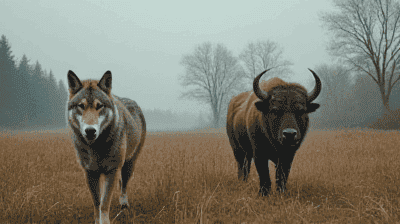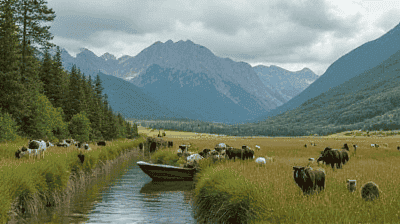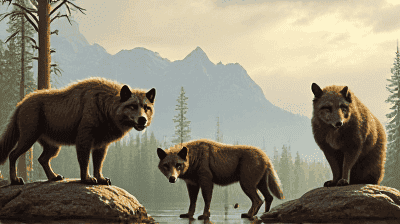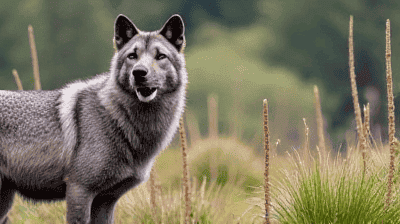
In recent years, the concept of rewilding has gained traction as a transformative approach to ecosystem restoration. Rewilding promotes the reintroduction of native species and the restoration of natural processes to rejuvenate landscapes that have been altered or degraded by human activity. In Europe, the rewilding movement has focused on keystone species such as wolves, bison, and beavers, all of which play critical roles in shaping their environments.
Rewilding is an ecological restoration strategy that focuses on returning ecosystems to their natural state by reintroducing native species and allowing natural processes to govern the landscape. Unlike traditional conservation methods that often involve active management and human intervention, rewilding emphasizes minimal human interference, letting nature reclaim and restore itself.
Core Areas: Establishing large, protected areas where wildlife can thrive without significant human disturbances. These core areas serve as refuges for biodiversity.
Species Reintroduction: Introducing keystone species that can help restore ecosystem balance. Keystone species are organisms that have a disproportionately large impact on their environment relative to their abundance.
Natural Processes: Allowing natural processes such as predation, herbivory, and natural fires to shape ecosystems. These processes are essential for maintaining healthy and resilient landscapes.
Connectivity: Creating corridors that connect fragmented habitats, allowing wildlife to move freely between these areas and fostering genetic diversity.
Rewilding offers numerous ecological, social, and economic benefits, including:
Enhanced Biodiversity: By reintroducing species and restoring natural habitats, rewilding can lead to increased biodiversity and more robust ecosystems.
Ecosystem Services: Healthy ecosystems provide essential services such as carbon sequestration, water filtration, and flood mitigation, which contribute to human well-being.
Cultural and Recreational Opportunities: Rewilding initiatives can lead to the creation of natural spaces for recreation and learning, fostering a deeper connection between people and nature.
Economic Opportunities: Ecotourism and sustainable land management practices can provide viable economic alternatives to traditional resource extraction.

Wolves (Canis lupus) are apex predators that play a crucial role in maintaining healthy ecosystems. Their presence has far-reaching effects that can influence the entire food web.
Trophic Cascade: Wolves help regulate herbivore populations, such as deer and elk. By keeping these populations in check, wolves prevent overgrazing, which can lead to habitat degradation and loss of plant diversity.
Habitat Creation: The absence of wolves can lead to overbrowsing by herbivores, resulting in the loss of plant species and changes in habitat structure. By controlling herbivore numbers, wolves help maintain diverse and resilient ecosystems.
Scavenger Benefits: Wolves also provide food for scavengers when they leave behind carcasses. Species such as ravens, foxes, and bears benefit from these remains, enhancing overall biodiversity.
In Eastern Europe, reintroducing wolves to the Carpathian Mountains has been a focus of recent conservation efforts. This initiative aims to restore wolf populations to help control deer numbers and rehabilitate overgrazed forest areas.
Monitoring and Management: Conservation organizations have employed monitoring techniques to study wolf behaviors and interactions with other species, ensuring that the reintroduction is successful and beneficial.
Community Involvement: Engaging local communities in conservation efforts has been key to the success of the project, fostering coexistence between humans and wolves.
In the Western Alps, wolves have begun to reclaim former territories, signaling a positive trajectory for the rewilding movement in this region. The return of wolves has led to ecological improvements, particularly in controlling the populations of herbivores that had become overabundant.
The European bison (Bison bonasus) is the continent's heaviest land animal and plays a significant role in shaping ecosystems.
Grazing Dynamics: Bison are key grazers that help maintain grasslands and forest clearings. Their grazing patterns prevent overgrowth and promote plant diversity, creating healthier habitats for other species.
Soil Aeration: As bison move through their environment, they trample the soil, which helps with aeration and nutrient cycling. This can lead to increased plant growth and soil fertility.
Habitat Creation: By grazing on certain plant species, bison create open spaces that provide habitat for other wildlife, including birds, insects, and small mammals.
The reintroduction of European bison is one of the most significant successes of the rewilding movement.
The Białowieża Forest, a UNESCO World Heritage Site, is home to one of the last remaining populations of European bison. The success of bison conservation in this region has served as a model for rewilding efforts elsewhere.
Population Recovery: Through intensive breeding programs and strict protection measures, the European bison population has rebounded from near extinction in the early 20th century.
Bison Corridors: Efforts to connect populations through corridors and create additional habitat patches have expanded the bison's range, enhancing genetic diversity.
The EuroBison project aims to establish new populations of European bison across various European countries, thus creating a network of bison populations that can thrive in semi-natural environments.
Collaborations: The project involves collaboration between conservation organizations, local governments, and communities to ensure that bison populations can coexist with agricultural practices and tourism.
Ecosystem Restoration: The reintroduction of bison to different landscapes is expected to help restore ecosystems by promoting biodiversity and enhancing habitat quality.

Beavers (Castor fiber) are known as ecosystem engineers due to their ability to alter landscapes significantly.
Wetland Creation: By building dams, beavers create ponds and wetlands, which serve as critical habitats for numerous plant and animal species. These wetlands can improve water quality and enhance biodiversity.
Hydrological Benefits: Beaver ponds help regulate water flow, reducing the risk of flooding downstream and improving water retention. This can be particularly valuable in agricultural regions where water management is crucial.
Carbon Sequestration: Wetlands created by beaver activity sequester carbon, contributing to climate change mitigation by capturing atmospheric CO2 in plant biomass and soil.
Beaver populations in Europe have been recovering in recent decades, thanks to conservation efforts that promote their reintroduction.
One of the most notable rewilding initiatives involving beavers is the Scottish Beaver Trial, which aimed to monitor the impacts of beaver reintroduction in a controlled environment.
Ecosystem Impact Assessments: The trial demonstrated that beaver activity significantly enhanced biodiversity within the study areas, leading to increases in species richness and habitat diversity.
Community Education: Engaging local communities through education and outreach programs has helped to mitigate conflicts and foster acceptance of beavers in the landscape.
In Poland, beaver populations have been successfully reintroduced to rivers and wetlands, resulting in notable ecological benefits.
Restoration of Aquatic Habitats: The reintroduced beavers have created new wetland areas that serve as crucial habitats for amphibians, fish, and various bird species.
Collaboration with Farmers: Programs have been implemented to educate farmers about coexisting with beavers and the benefits of wetlands for water management and biodiversity.
As keystone species are reintroduced into landscapes, conflicts with human populations can arise. Common challenges include:
Livestock Predation: The reintroduction of wolves can lead to concerns about livestock predation, necessitating management strategies to alleviate farmer concerns.
Property Damage: Beavers may cause flooding or damage to agricultural land, leading to potential conflicts with farmers and landowners.
Successful rewilding initiatives must find a balance between ecological restoration and the needs of local communities:
Participatory Management: Involving local communities in decision-making can help alleviate concerns and foster support for rewilding efforts.
Economic Incentives: Providing economic incentives for conservation—such as payment for ecosystem services—can encourage local buy-in and support.
Education and Outreach: Educational initiatives can help build understanding of the long-term benefits of rewilding and promote coexistence strategies.
Climate change poses additional challenges to rewilding efforts:
Shifting Habitats: Changes in temperature and precipitation patterns can influence species distributions and alter the effectiveness of rewilding initiatives.
Ecosystem Resilience: Promoting resilient ecosystems through biodiversity and habitat restoration can help mitigate the impacts of climate change on wildlife populations.

Rewilding in Europe presents exciting opportunities for restoring landscapes, enhancing biodiversity, and fostering a deeper connection between people and nature. By reintroducing wolves, bison, and beavers, conservationists are working to restore the ecological balance necessary for thriving ecosystems.
While the potential of rewilding is immense, it is essential to approach these initiatives thoughtfully, addressing the challenges that arise and ensuring that the needs of local communities are met. By facilitating coexistence and promoting engagement, rewilding can serve as a catalyst for positive environmental change, benefiting ecosystems, wildlife, and the communities that depend on them.
As we move forward in our efforts to restore Europe's landscapes, the lessons learned from these initiatives can inform conservation strategies globally, paving the way for a more sustainable and harmonious relationship between humans and the natural world.